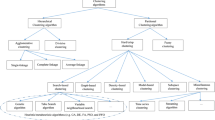Abstract
Evolutionary algorithms, such as shuffled frog lea**, are stochastic search methods that mimic natural biological evolution and/or the social behavior of species. Such algorithms have been developed to arrive at near-optimum solutions to complex and large-scale optimization problems which cannot be solved by gradient-based mathematical programming techniques. The shuffled frog-lea** algorithm draws its formulation from two other search techniques: the local search of the “particle swarm optimization” technique and the competitiveness mixing of information of the “shuffled complex evolution” technique. Cluster analysis is one of the attractive data mining techniques which is used in many fields. One popular class of data clustering algorithms is the center-based clustering algorithm. K-means is used as a popular clustering method due to its simplicity and high speed in clustering large datasets. However, k-means has two shortcomings: Dependency on the initial state and convergence to local optima and global solutions of large problems cannot be found with reasonable amount of computation effort. In order to overcome local optima problem, lots of studies are done in clustering. In this paper, we proposed an application of shuffled frog-lea** algorithm in clustering (SFLK-means). We compared SFLK-means with other heuristics algorithm in clustering, such as GAK, SA, TS, and ACO, by implementing them on several simulations and real datasets. Our finding shows that the proposed algorithm works better than others.
Similar content being viewed by others
References
Ward JW (1963) Hierarchichal grou** to optimize an objective function. J Am Stat Assoc 58:236–244. doi:10.2307/2282967
Selim SZ, Ismail MA (1984) K-means type algorithms: a generalized convergence theorem and characterization of local optimality. IEEE Trans Pattern Anal Mach Intell 6:81–87
Spath H (1989) Clustering analysis algorithms. Ellis Horwood, Chichester, UK
Maulik U, Bandyopadhyay S (2000) Genetic algorithm-based clustering technique. Pattern Recognition 33:1455–1465
Krishna K, Murty N (1999) Genetic k-means algorithm. IEEE Trans Syst, Man Cybernet—Part B: Cybernetics 29:433–439
Shokri Z, Selim, Al-Sultan K (1991) A simulated annealing algorithm for the clustering problem. Pattern Recognition 24(10):1003–1008. doi:10.1016/0031-3203(91)90097-O
Sung CS, ** HW (2000) A Tabu-search-based heuristic for clustering. Pattern Recognition 33:849–858. doi:10.1016/S0031-3203(99)00090-4
Kuo RI, Wang HS, Hu T-L, Chou SH (2005) Application of ant K-means on clustering analysis. Comput Math Appl 50:1709–1724. doi:10.1016/j.camwa.2005.05.009
Shelokar PS, Jayaraman VK, Kulkarni BD (2004) An ant colony approach for clustering. Anal Chim Acta 509:187–195. doi:10.1016/j.aca.2003.12.032
Garey MR, Johnson DS, Witsenhausen HS (1982) The complexity of the generalized Lloyd–Max problem. IEEE Trans Inf Theory 28(2):255–256. doi:10.1109/TIT.1982.1056488
Gungor Z, Unler A (2007) K-harmonic means data clustering with simulated annealing heuristic. Appl Math Comput 184:199–209
Reynolds CW (1987) Flocks, herds and schools: a distributed behavioral model. Comput Graph 21(4):25–34. doi:10.1145/37402.37406
Heppner F, Grenander U (1990) A stochastic nonlinear model for coordinated bird flocks. In: Krasner S (ed) The ubiquity of chaos. AAAS, Washington, DC, pp 233–238
Wilson EO (1975) Sociobiology: the new synthesis. Belknap, Cambridge, MA
Eusuff M, Lansey K, Pasha F (2006) Shuffled frog-lea** algorithm: a memetic meta-heuristic for discrete optimization. Eng Optim 38(2):129–154. doi:10.1080/03052150500384759
Kennedy J, Eberhart R (1995) Particle swarm optimization. Proceedings of the IEEE International Conference on Neural Networks. IEEE Service Center, Piscataway, NJ, pp 1942–1948
Duan QY, Gupta VK, Sorooshian S (1993) Shuffled complex evolution approach for effective and efficient global minimization. J Optim Theory Appl 76:502–521. doi:10.1007/BF00939380
Eusuff MM, Lansey KE (2003) Optimizing of water distribution network design using the shuffled frog lea** algorithm. J Water Resour Plan Manage 129(3):210–225. doi:10.1061/(ASCE)0733-9496(2003)129:3(210)
Elbeltagi E, Hegazy T, Grierson D (2005) Comparison among five evolutionary-based optimization algorithms. J Adv Eng Inform 19:43–53. doi:10.1016/j.aei.2005.01.004
Pal SK, Majumder DD (1977) Fuzzy sets and decision making approaches in vowel and speaker recognition.. IEEE Trans Syst Man Cybernet SMC-7:625–629
Blake CL, Merz CJ. UCI repository of machine learning databases. Available from <http://www.ics.uci.edu/_mlearn/MLRepository.html>
Johnson RA, Wichern DW (1982) Applied multivariate statistical analysis. Prentice-Hall, Englewood Cliffs, NJ
Emad E, Tarek H, Donald G (2005) Comparison among five evolutionary-based optimization algorithms. Adv Eng Inform 19:43–53. doi:10.1016/j.aei.2005.01.004
Author information
Authors and Affiliations
Corresponding author
Rights and permissions
About this article
Cite this article
Amiri, B., Fathian, M. & Maroosi, A. Application of shuffled frog-lea** algorithm on clustering. Int J Adv Manuf Technol 45, 199–209 (2009). https://doi.org/10.1007/s00170-009-1958-2
Received:
Accepted:
Published:
Issue Date:
DOI: https://doi.org/10.1007/s00170-009-1958-2




